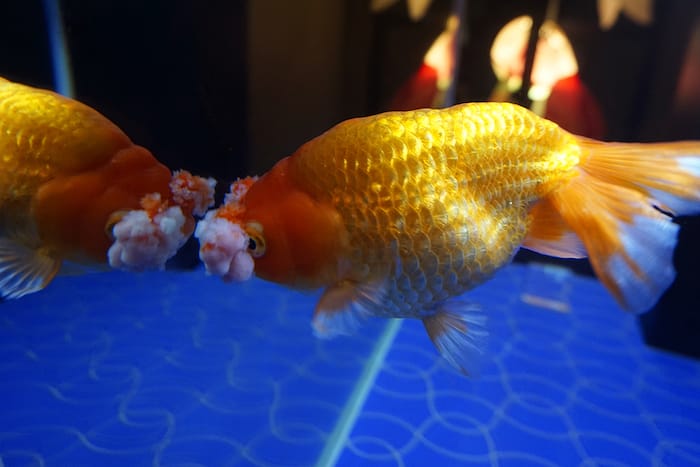Introduction: The pompom goldfish is a fascinating and unique fancy goldfish breed that captures the attention of aquarists with its distinctive pompon-like growths. In this comprehensive guide, we will delve into the characteristics of the pompom goldfish and provide valuable insights on how to properly care for this captivating aquatic companion.

The Pompom Goldfish’s Unique Features
The pompom goldfish derives its name from the fleshy lobed nasal septa that resemble pompons. These adorable growths, connected to the goldfish’s nasal septum, serve as sensory organs, enabling them to detect airborne chemicals and odors. The body of a true pompom goldfish is reminiscent of ranchu types, characterized by a rounded body without a dorsal fin. Pompoms are available in a variety of colors, including metallic and calico variations.
Qualities of a High-Quality Pompom Goldfish
When selecting a pompom goldfish, it is important to look for certain traits that indicate a high-quality specimen. A top-notch pompom should exhibit a solid and uniform growth, free from deformities or irregularities. The spherical shape of the body is another key attribute to consider. The pompon lobes should not extend downward into the mouth, ensuring the goldfish’s ability to eat and swim without hindrance. By carefully inspecting these characteristics, you can find a pompom goldfish that embodies the breed’s true beauty.
Care Tips
Suitable Living Environment
Creating an optimal living environment is crucial for the well-being of your pompom goldfish. Consider the following care requirements:
Tank Size
Pompom goldfish thrive in spacious aquariums that allow them to swim freely. A minimum tank size of 20 gallons is recommended for a single pompom, with additional space for each additional goldfish.
Water Temperature
Pompoms are best kept in water temperatures ranging from 65°F to 75°F (18.3°C to 23.9°C). Ensure the tank is equipped with a reliable heater to maintain a consistent temperature.
Water Quality
Regularly monitor water parameters such as pH, ammonia, nitrite, and nitrate levels to ensure a healthy aquatic environment. Perform regular water changes to maintain water quality.
Tank Setup
Pompoms appreciate a well-decorated tank with ample hiding spots and gentle water flow. Provide live or artificial plants, smooth rocks, and driftwood to create a stimulating and aesthetically pleasing environment.
Compatible Tank Mates
When selecting tank mates for your pompom goldfish, it is important to consider their delicate nature and slow-moving behavior. Ideal companions include other fancy goldfish breeds such as the telescope, oranda, bubble eye, and celestial. Avoid introducing fast-swimming or aggressive species that may outcompete or cause stress to the pompom goldfish.
Nutritional Needs
Maintaining a balanced diet is crucial for the health and vitality of your pompom goldfish. Feed them a high-quality goldfish pellet or flake food specifically formulated for fancy goldfish. Supplement their diet with occasional treats such as freeze-dried or frozen foods like bloodworms or brine shrimp. Avoid overfeeding to prevent swim bladder issues and obesity.
Conclusion
The pompom goldfish stands out among other fancy goldfish breeds with its unique pompon-like growths and charming personality. By providing a suitable living environment, maintaining water quality, and offering a balanced diet, you can ensure the well-being and longevity of your pompom goldfish. As you admire their beauty and observe their playful nature, you will undoubtedly develop a deep appreciation for this captivating aquatic companion.
Sources:
- Stoskopf, M. (1993). Goldfish Varieties and Genetics: A Handbook for Breeders. T.F.H. Publications.
- Alderton, D. (2008). Goldfish: A Complete Introduction. Firefly Books.
Reviewed By: Tim Winter

Tim Winter has a strong affection for pets and wildlife. His years of experience caring for various types of pets has led him to share his knowledge with others on the best practices in pet care. Tim holds a Bachelor of Science from the University of Oregon School of Journalism and Communications.
